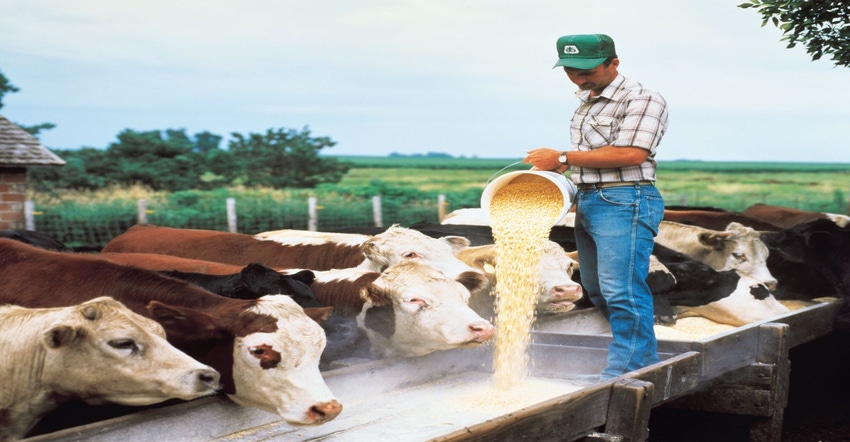April 13, 2022

Potential for corn availability
USDA’s Prospective Plantings report released on March 30th has created quite a bit of conversation about the 2022 grain supply and its subsequent impacts on cattle production. The report indicated that there would be a reduction in corn acreage. This reduction was almost entirely captured by an increase in soybean acreage rather than in other crops. The general commentary about why this reduction occurred given the incentives and potential profits for planting corn are:
Input supply risks – lack of availability of fertilizer, primarily nitrogen, and herbicide. Fertilizer for corn that was pre-purchased is fixed but the ability to purchase additional fertilizer to switch acres is less available, or at least at marginally profitable levels.
Crop rotation considerations – potential increase in crop disease and reduced soil nutrients due to a corn-to-corn rotation. This concern is primarily in states that have a higher corn-to-soybean rotation ratio such as Iowa. If producers needing to get in a year of soybeans into the rotation perhaps this is the year.
Optimists point to two conditions that could force more substitution away from soybeans into corn. First, there is always some switching that occurs between intentions and actual plantings due to market reactions and relative price ratios. Second, an early planting window would favor more corn being planted as the corn would be able to get in more growing degree days prior to the arrival of hot weather thus reducing potential damages. However, even if producers wanted and were able to switch from soybeans into corn, they could still be limited if they are just unable to get the necessary inputs for a successful crop.
Potential for distillers grains availability
There is a large focus on the corn market because a large portion of most cattle finishing diets is protein but can come in the form of corn (i.e. dry rolled corn, steam flaked corn, high moisture corn, or ground corn) which is sometimes fed with a combination of distillers grains (i.e. dried, modified, or wet distillers grains). Distillers’ grains are generally fed up to a 40% inclusion but the inclusion level and type of distillers grain used can vary given local availability. Cattle feeders who use distillers grains, primarily in the wet form, are closely watching ethanol production numbers given the potential for ethanol plant slowdowns. Over the past two years, distillers grain price (as a percent of corn price on a dry matter basis) has been very volatile due to both more movement in the corn market and ethanol idling. Currently, ethanol production has kept pace with national weekly ethanol production – approximately at pre-COVID levels even with significantly higher corn prices (EPA 2022). Since oil and ethanol are highly correlated, one would expect ethanol plants to continue to be profitable even at higher prices corn and gasoline prices. However, Iowa State University Ethanol Profitability Tracker indicates the relative price increase in ethanol ($/gal.) have not been sufficiently high compared to the cost of corn ($/bu.). Net returns are calculated to be -$0.28 per gal. of ethanol, its lowest level since last winter in the last run-up in grain prices.
Impact of feed costs on projected cost of gain
Ultimately, higher corn and distiller grain prices increase the cost of gain for feedlots. Kansas State University’s Focus on Feedlot report indicates the cost of gain has risen significantly (see Table 1). Steers placed early in 2022 had an expected cost of gain of approximately $124 per cwt. and heifers were approximately $128 per cwt. Both were up from $102 and $106 per cwt. a year ago. Using CME deferred futures would suggest that there are still profits to be made. However, these potential profits have eroded since the release of USDA’s Prospective Plantings report. Prior to the release, CME Live Cattle futures had some slight upward momentum – most contracts gaining about $2-3 per cwt. over the previous two weeks. Since the release, live cattle prices have eroded between $2-4 per cwt. with larger declines occurring in more nearby months. This is further narrowing profit margins.
Manure as a potential source of additional revenue
There is a potential win-win among grain producers and livestock producers this year. The significantly higher fertilizer costs and potential supply disruptions have created some incentives for grain producers to source manure from feedlots, hog, and poultry operations. If feedlots have properly collected and stored manure, then selling manure could be a potential source for additional revenue. Although the actual value will depend on the nutrient content which is in part determined by the cattle diet (Schmidt, 2016). Further, the type of facility (i.e. open-yard, bed-pack, or slat-floor barn) will likewise impact the nutrient content and thus the value of the manure. Given manure production estimates for a 999-head open yard facility and current Urea and DAP prices, the value of manure could be in the range of $60 per head or approximately $4.30 per cwt. for a 1400 lb. steer (see Manure Value, authors’ calculations). Selling manure would bring value back to the feedlot while relieving some concerns of access to nitrogen allowing for more rotation into corn from soybeans. How much selling will occur, and thus potential crop rotation, likely depends on the working relationships between crop and local feedlots, the feedlot organizational structure (i.e. farmer feeder vs. commercial feedlot), nutrient content of manure, and existing manure contracts – among other considerations.
Source: University of Nebraska-Lincoln, which is solely responsible for the information provided and is wholly owned by the source. Informa Business Media and all its subsidiaries are not responsible for any of the content contained in this information asset.
You May Also Like




